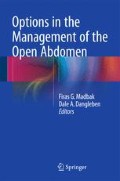Abstract
Defects of the abdominal wall have many etiologies, ranging from congenital malformations, trauma, burns, and radiation to those caused by surgical intervention for a variety of disease processes. The resultant defects can be broadly classified into partial thickness and full thickness defects depending on the components involved. Furthermore, the acuity of the wound could influence reconstruction options. Based on the extent of the wound and involvement of adjacent structures, reconstructive maneuvers may range from simple primary closure to microsurgical free tissue transfer. For complex reconstructions, a collaborative approach between acute care, trauma, and plastic surgeons may yield the most durable, functional, and aesthetic outcomes.
Access this chapter
Tax calculation will be finalised at checkout
Purchases are for personal use only
References
Amid PK. Classification of biomaterials and their related complications in abdominal wall hernia surgery. Hernia 1997;1(1):15–21.
An G, Walter RJ, Nagy K. Closure of abdominal wall defects using acellular dermal matrix. J Trauma 2004;56(6):1266–75.
Badylak S, Kokini K, Tullius B, Whitson B. Strength over time of a resorbable bioscaffold for body wall repair in a dog model. J Surg Res. 2001;99(2):282–7.
Butler CE. The role of bioprosthetics in abdominal wall reconstruction. Clin Plastic Surg. 2006;33(2):199–211.
DeFranzo AJ, Argenta L. Vacuum-assisted closure for the treatment of abdominal wounds. Clin Plast Surg. 2006;33(2):213–224.
de Vries Reilingh TS, van Geldere D, Langenhorst B, de Jong D, van der Wilt GJ, van Goor H, Bleichrodt RP. Repair of large midline incisional hernias with polypropylene mesh: comparison of three operative techniques. Hernia 2004;8(1):56–9.
de Vries Reilingh TS, van Goor H, Rosman C, Bemelmans MH, de Jong D, van Nieuwenhoven EJ, van Engeland MI, Bleichrodt RP. “Components separation technique” for the repair of large abdominal wall hernias. J Am Coll Surg. 2003;196(1):32–7.
Grevious MA, Cohen M, Jean-Pierre F, Herrmann GE. The use of prosthetics in abdominal wall reconstruction. Clin Plast Surg. 2006;33(2):181–97.
Gopinathan R, Granick M. Anterior abdominal wall reconstruction. Clin Plast Surg. 2006;33(2):259–67.
Jin J, Rosen MJ, Blatnik J, McGee MF, Williams CP, Marks J, Ponsky J. Use of acellular dermal matrix for complicated ventral hernia repair: does technique affect outcomes? J Am Coll Surg. 2007;205(5):654–60.
Koontz AR. Prelimiary report on the use of tantalum mesh in the repair of ventral hernias. Ann Surg. 1948;127(5):1079–85.
Koontz AR, Kimberly RC. Tissue reactions to tantalum gauze and stainless steel gauze: an experimental comparison. Ann Surg. 1953;137(6):833–40.
Lowe JB 3rd. Updated algorithm for abdominal wall reconstruction. Clin Plast Surg. 2006;33(2):225–40.
Nguyen V, Shestak KC. Separation of anatomic components method of abdominal wall reconstruction–clinical outcome analysis and an update of surgical modifications using the technique. Clin Plast Surg. 2006;33(2):247–57.
Porshinsky B, Ramasastry S. Abdominal wall reconstruction with free flaps. Clin Plast Surg. 2006;33(2):269–80.
Ramirez OM, Ruas E, Dellon AL. “Components separation” method for closure of abdominal-wall defects: an anatomic and clinical study. Plast Reconstr Surg. 1990;86(3):519–26.
Ramirez OM. Inception and evolution of the components separation technique: personal recollections. Clin Plast Surg. 2006;33(2):241–6, vi.
Rodriguez ED, Bluebond-Langner R, Silverman RP, Bochicchio G, Yao A, Manson PN, Scalea T. Abdominal wall reconstruction following severe loss of domain: the R Adams Cowley Shock Trauma Center algorithm. Plast Reconstr Surg. 2007;120(3):669–80.
Rohrich RJ, Lowe JB, Hackney FL, Bowman JL, Hobar PC. An algorithm for abdominal wall reconstruction. Plast Reconstr Surg. 2000;105(1):202–16, quiz 217.
Author information
Authors and Affiliations
Corresponding author
Editor information
Editors and Affiliations
Rights and permissions
Copyright information
© 2015 Springer Science+Business Media New York
About this chapter
Cite this chapter
Adkinson, J., Garza III, R., Shafqat, M., Miles, M. (2015). Considerations in Abdominal Wall Reconstruction. In: Madbak, F., Dangleben, D. (eds) Options in the Management of the Open Abdomen. Springer, New York, NY. https://doi.org/10.1007/978-1-4939-1827-0_6
Download citation
DOI: https://doi.org/10.1007/978-1-4939-1827-0_6
Published:
Publisher Name: Springer, New York, NY
Print ISBN: 978-1-4939-1826-3
Online ISBN: 978-1-4939-1827-0
eBook Packages: MedicineMedicine (R0)

